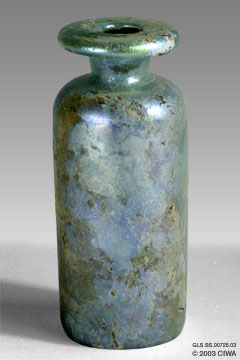Iridescent blue bottle, Syria, 100-300 AD

Links to other views:⇒ Larger Viewif scripting is off, click the ⇒ instead. Links to others of type BottleGlass unguentarium, Syria, 100-300 ADIridescent bottle, Roman world, 1-200 AD Pyriform glass bottle, Roman, 100-400 AD Pyriform glass bottle, Roman, 80-150 AD Small glass phial, Egypt, c. 900 AD Translucent glass bottle, Roman, 1-100 AD |
This small bottle presents several unusual characteristics. The uniformity of the iridescence is striking. The concave, smooth bottom has no pontil mark, and the perfect cylindrical shape with a perfect flattened infolded rim is uncommon. A closer examination reveals that the iridescent thin layer is on the inside of the bottle, showing through a perfectly transparent glass. Eastern Roman Empire, 300-400 AD. Parallels: “Flasche. Ht. 16.1 cm. Syria, 2nd - 4th century AD” (Münzen und Medaillen 1986:19 #62). Glass Iridescence The iridescent effect that so often enhances immeasurably the beauty of ancient glass was not planned by ancient glass artisans. Instead, it is the combined result of weathering processes and the properties of light. The rainbow effect you commonly experience in daily life, such as on soap bubbles or drops of oil spread on water, stem from the same action: light bouncing on a extremely thin transparent film. When a glass bottle is new, there is no such thin film. The wall of the bottle is homogenous. But “as glass is exposed to water in its burial environment, some of its [chemical] components can be dissolved by the water and carried away (leached out). This generates a thin surface layer of glass that has a different composition that the undegraded bulk of glass. Often, there is a think layer of air between the corroded surface and the bulk” (Bezúr 1999). When ordinary white light strikes the bottle, some of the rays bounce off the top surface of the thin film, and some go through the thin film and then bounce off the glass-air interface between the thin film and the underlying glass. When the rays coming back from the bottom of the thin film reemerge into open air, they combine with those that simply bounced off the surface. But since they have been delayed by their additional travel, their waves are no longer in phase (in synch). When these two streams of out-of-phase white light combine, some of the wavelengths cancel out (and therefore those colors disappear), and other wavelengths are reinforced (and therefore those colors become very intense), thus turning white light into vivid random colors. Glass artists of the late 19th Century, such as Louis Comfort Tiffany, admired the iridescence of Roman glass, and devised ways to produce it deliberately by placing the glass piece while still very hot in an oven filled with vapors (tin and iron chlorides) that would alter the surface and create a thin film of different composition, yielding an iridescent effect that did not require a thousand years to develop. A more thorough technical discussion of the phenomenon by Aniko Bezúr of the University of Arizona Department of Materials Science and Engineering is available from http://www.u.arizona.edu/ic/mse257/class_notes/iridescence.pdf Bibliography (for this item)Münzen und Medaillen,1986 Auktion 70. Kunswerke der Antike. Münzen und Medaillen, Basel, Swizerland. (19 # 62) Bibliography (on Glass Iridescence)Bezur, Aniko1999 Online Notes on Iridescence (http://www.u.arizona.edu/ic/mse257/class_notes/iridescence.pdf). University of Arizona, Department of Materials Science and Engineering, Tucson, AZ. |